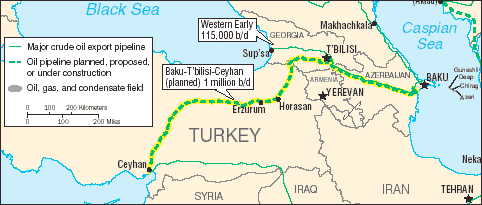Baku-Tbilisi-Ceyhan pipeline from the Turkish Wikipedia: Part 1
Tuesday, April 22, 2008
I noticed today that the Turkish edition of the Baku-Tbilisi-Ceyhan pipeline article is about the same size but written quite differently from the English version, so it might be worth it to translate it into English in case it has any information not present in English.
As always I will do my best to provide an accurate translation but provide no guarantees. Also don't forget that this is Wikipedia so be sure to double check anything before quoting anything from the article. I'll see if I can provide links to back up any information though.
I have no idea how many days this will require. I'll also be skipping any parts I don't feel to be relevant or interesting (like a part on Azerbaijan during the 1920s). Here's the source.
Bakü–Tiflis–Ceyhan Petrol Boru Hattı ya da kısaca BTC, Azerbaycan petrolünü Gürcistan üzerinden Türkiye’nin Akdeniz kıyılarına taşıyan petrol boru hattı. Temmuz 2006 tarihinde hizmete girmiştir.The Baku-Tbilisi-Ceyhan petrol pipeline or BTC for short, is a pipeline for petrol from Azerbaijan through Georgia, and thereafter to Turkey's coast on the Mediterranian Sea. It went into service in July 2006.
Tüm Dünya'da ucuz ve istikrarlı enerji kaynaklarına sahip olabilmek için yoğun bir mücadelenin yaşandığı ve Sovyetler Birliği’nin 1991 yılının sonunda resmen dağılmasının ardından Kafkaslar ve Hazar Denizi çevresinin bu mücadelenin en çok hissedildiği bölge olduğu düşüldüğünde BTC Boru Hattı'nın statejik bir öneme sahip olduğu söylenebilir.The BTC pipeline has large strategic value due to:
- Struggles throughout the world for a cheap and stable source of energy
- This struggle is thought to be most felt in the Caucasus and Caspian Sea region after the USSR's breakup in 1991
Bakü - Ceyhan projesiBaku - Ceyhan project
1989 yılında, Ramco adlı İngiliz petrol şirketinin temsilcisi olan Steve Remp’in Bakü’ye gelmesiyle BTC hattının öyküsü de başlamış olur. Azerbaycan Devlet Petrol Şirketi (ADPŞ), 1990 yılında Remp’ten Azeri petrollerinin Batı’ya pazarlanması amacıyla büyük petrol şirketleriyle temaslarda bulunmasını talep eder. Remp öncelikle British Petroleum (BP) ile ilişkiye geçer.In 1989, a representative named Steve Remp from a British oil company called Ramco came to Baku, and the BTC pipeline's story began. The State Oil Company of Azerbaijan Republic (SOCAR - name in Turkish is Azerbaycan Devlet Petrol Şirketi or ADPŞ) requested a meeting from Remp with large oil companies to get Azeri petrol on the market in the west. Remp first established contact with British Petroleum (BP).
Hemen 1991 yılının başında Amoco isimli bir diğer petrol devi de devreye girer. Temmuz ayında Amoco firması Azeri isimli petrol sahasıyla ilgili hakları kazanır. Aynı yıl 30 Ağustos’ta Azerbaycan bağımsızlığını ilan eder. Bunun hemen ardından da Azerbaycan ile Ermenistan arasında Dağlık Karabağ sebebiyle çatışmalar başlar ve bu yüzden petrol konusundaki ilerlemeler bir süreliğine kesintiye uğrar.Soon after in the beginning of 1991 another petrol giant named Amoco started to take part. In July the Amoco company obtained the rights to an Azeri oil field. In the same year on the 30th of August Azerbaijan declared its independence. Right after that the Nagorno-Karabakh conflicts started between Azerbaijan and Armenia, and because of this any progress to do with oil was cut off for a period of time.







0 comments:
Post a Comment